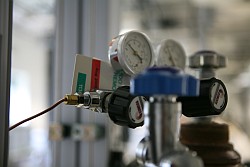Tech Tip 10: Installing a capillary column into a GC inlet/detector (Part II)
Submitted by anthias on
 The installation of a capillary column into a modern gas chromatograph requires precise positioning of the column into both the inlet/injection port and the detector to obtain optimum analytical performance. Individual manufacturers have different requirements for the optimum insertion length and positioning of the column which should be checked from the relevant instrument operating manual.
The installation of a capillary column into a modern gas chromatograph requires precise positioning of the column into both the inlet/injection port and the detector to obtain optimum analytical performance. Individual manufacturers have different requirements for the optimum insertion length and positioning of the column which should be checked from the relevant instrument operating manual.

 The installation of a capillary column into a modern gas chromatograph requires precise positioning of the column into both the inlet/injection port and the detector to obtain optimum analytical performance. Individual manufacturers have different requirements for the optimum insertion length and positioning of the column which should be checked from the relevant instrument operating manual.
The installation of a capillary column into a modern gas chromatograph requires precise positioning of the column into both the inlet/injection port and the detector to obtain optimum analytical performance. Individual manufacturers have different requirements for the optimum insertion length and positioning of the column which should be checked from the relevant instrument operating manual.

 Tips on connecting capillary columns together using the press-fit connector.
Tips on connecting capillary columns together using the press-fit connector. Knowing where your gas cylinders are located and regularly checking the contents is very important for any gas chromatographer when troubleshooting an instrument. People responsible for the cylinders go on holiday or leave and the first the instrument operators knows about it is when they run out of gas and then it is a major panic!
Knowing where your gas cylinders are located and regularly checking the contents is very important for any gas chromatographer when troubleshooting an instrument. People responsible for the cylinders go on holiday or leave and the first the instrument operators knows about it is when they run out of gas and then it is a major panic! Most problems that occur in Gas Chromatography either gradually increase in severity over time or suddenly become a large issue, preventing further analysis by the instrument.
Most problems that occur in Gas Chromatography either gradually increase in severity over time or suddenly become a large issue, preventing further analysis by the instrument. Splitless injections are used to transfer all of the injected analytes onto the analytical column for separation and detection and are therefore used for low concentration samples.
Splitless injections are used to transfer all of the injected analytes onto the analytical column for separation and detection and are therefore used for low concentration samples. Obtaining the best resolution for the method is critical for accurate qualitative and quantitative analysis, especially where chromatographic resolution is relied upon with standard GC detectors, as there is no MSD to take advantage of analytical resolution.
Obtaining the best resolution for the method is critical for accurate qualitative and quantitative analysis, especially where chromatographic resolution is relied upon with standard GC detectors, as there is no MSD to take advantage of analytical resolution. Sample introduction or the GC inlet parameters are very often overlooked when developing a GC or GC-MS method, but these parameters are so powerful that they can result in success or total failure of an application and as a result are also the main area for troubleshooting and maintenance within the GC system.
Sample introduction or the GC inlet parameters are very often overlooked when developing a GC or GC-MS method, but these parameters are so powerful that they can result in success or total failure of an application and as a result are also the main area for troubleshooting and maintenance within the GC system.